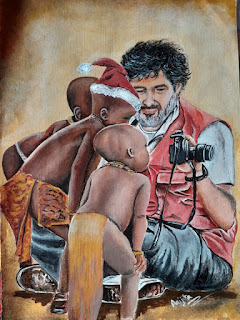SPOTLIGHT ON: ANJANEYULU G
Elevating Ordinary to the Extraordinary
Anjaneyulu G
A bowl laden with fruits, cutlery strewn around, a candelabra and candles all arranged on a table the way these items are in our daily lives, have made for a powerful, captivating picture for some centuries now. Either this, or a combination of other such mundane, household items, have always formed an important stage in an artist's life, which art academics refer to as Still-Life paintings.
Still-Life is one of the most well-known and admired genres of painting, even though many lay admirers of art may not know it is as 'Still-Life' painting that they are admiring! For the uninitiated, it originated as an independent genre during 16th-17th centuries in Europe—during the late Renaissance period—with the Dutch artists adopting it most successfully. The term itself comes from the Dutch 'stilleven', implying motionless natural objects.
In India, the genre made its debut in the latter half of the 19th century when it started getting taught at the art schools run by the colonial rulers in the presidency towns of Bombay, Calcutta and Madras. In India, it's a genre that has been attempted by almost every artist since those earliest times, and continues to be essayed even today, even though it does not make a frequent appearance in contemporary galleries. Therefore, the show 'Past Forward', currently on view at Art Alive Gallery in Panchsheel Park, New Delhi, came like a refreshing, scented breeze on a humid, stuffy monsoon evening.
On view through September 7, the show comprises canvases with bright backgrounds, nestling ordinary household items such as kitchen utensils, etc., in the foreground. Their worth lies in their shiny, metallic surfaces, prominently wearing the marks of regular use over the years, through which they tell stories of the households they belong to, giving a peep into the life of the people who use them.
This is Still-Life at its innovative, contemporary best. Mesmerised by canvases upon canvases cradling such stories that one needs to pause and listen to, I had a brief interaction with the creator of these spellbinding works, the Hyderabad-based artist Anjaneyulu G. He holds a BFA from the College of Fine Art, Jawaharlal Nehru Technological University, Hyderabad, and has several group and solo shows to his credit, as also displays at numerous art fairs, including the India Art Fair.
Here are the excerpts of my interaction with Anjaneyulu G.
Q. How and when did you get inspired by Still-Life as a genre of painting?
I stumbled upon Still-Life painting as a genre that resonated with me when I realized its vast, untapped potential. Many artists overlook Still-Life, perceiving it as mundane or unchallenging. However, I saw this as an opportunity to breathe new life into a traditional genre.
My fascination with Still-Life began when I started experimenting with single objects on plain backgrounds. This simplicity allowed me to focus on the essence of the object, exploring its texture, form, and relationship with light.
As I delved deeper, I became intrigued by the idea of combining objects from different eras and materials, like bronze and stainless steel, to create visually striking contrasts and reflections. This juxtaposition sparked a new wave of inspiration, enabling me to explore themes of time, memory, and the interplay between the old and the new.
My 'aha' moment came when I realized that Still-Life, often regarded as an 'unfinished' genre, offered me the freedom to innovate and push boundaries. I embraced this challenge, and Still-Life became my genre of choice. I aim to elevate the ordinary to the extraordinary, inviting viewers to rediscover the beauty in the every day.
Q.
What was the inspiration behind the series of pots and common household
utensils that you paint? When did you first start painting this series?
I’ve been fascinated with Still-Life for 15 years, exploring compositions, lighting, and human connections with objects. My recent series, which I spent 18 months developing, focuses on pots and household utensils. I’m drawn to their everyday familiarity, the stories they hold, and the emotions they evoke. By combining traditional and modern objects, I aim to capture the essence of domesticity, memory, and the passage of time.
By depicting marks of use and wear, I highlight the human connection and history behind each object. My focus is on the objects’ journey, the hands that held them, and the memories they evoke. I believe these objects hold a quiet narrative, revealing the essence of the households they come from and the people who used them.
Q.
You have been called a ‘chronicler of mundane life’. What other objects of
mundane life fascinate you?
I’m drawn to objects that hold a sense of familiarity
and nostalgia. In the future, I’d like to explore painting objects that hold
personal significance to me, delving into autobiographical themes and stories.
I’m interested in capturing the emotional connection between myself and these
objects, revealing the memories and experiences they evoke.
Q.
Any artists whose works have inspired you?
I draw inspiration from a range of artists, including
Giorgio Morandi and Jean-Siméon Chardin, who mastered the art of Still-Life and
capturing the quiet beauty in everyday objects. I’m also influenced by the
works of Hokusai and Bruegel, as well as the timeless beauty of Japanese and ancient
Chinese art. The compositions, colors, and attention to detail in these styles
resonate with me, shaping my approach to Still-Life painting and my desire to
elevate the mundane to the extraordinary.
Q.
What are you working on currently?
I’m currently working on a new series of paintings that explore the theme of ‘domesticity’ in more depth. I’m experimenting with new compositions, colors, and techniques to capture the warmth and intimacy of everyday life. Specifically, I’m focusing on the relationships between objects, textures, and light in domestic spaces. It’s an exciting project that allows me to continue exploring the beauty in the mundane and the stories that objects tell.
.jpg)












